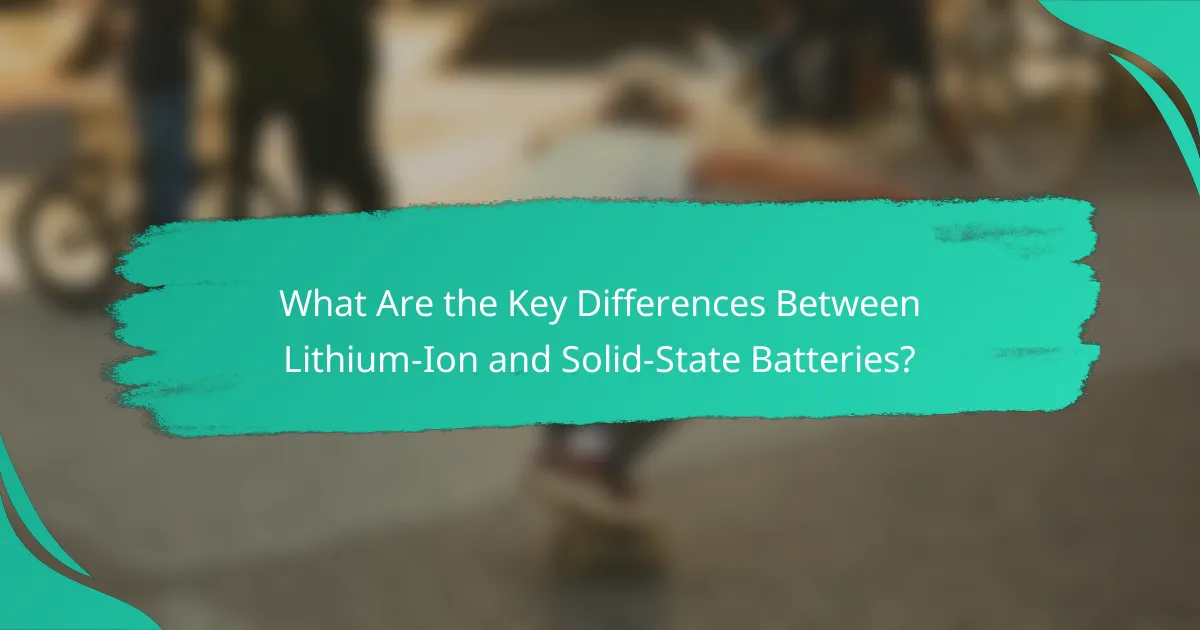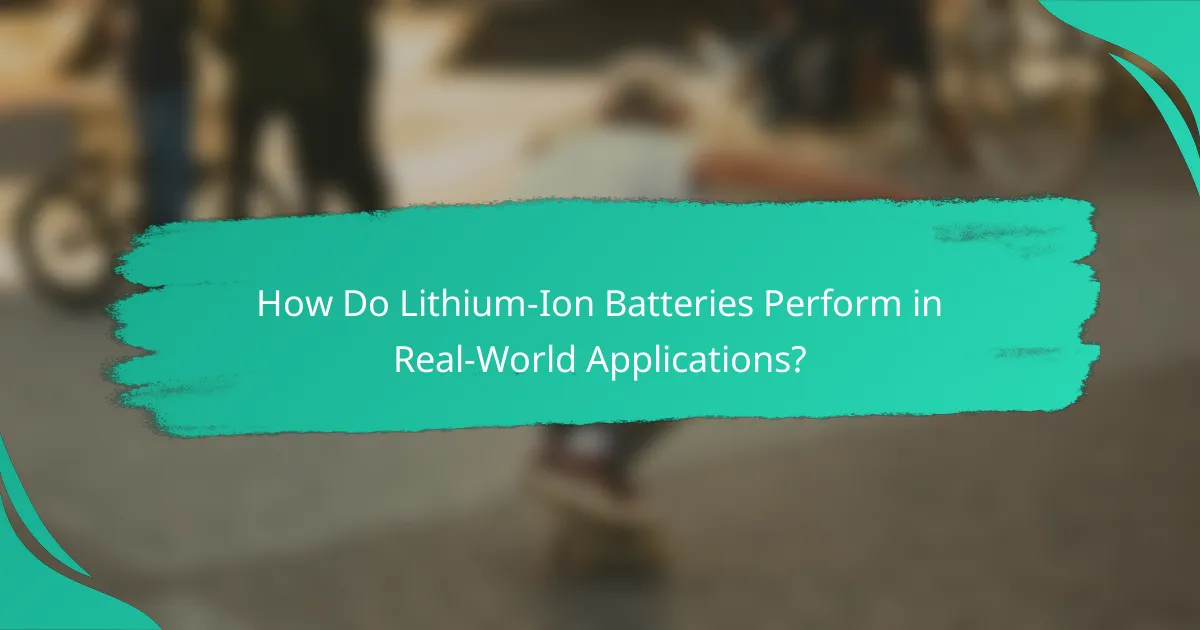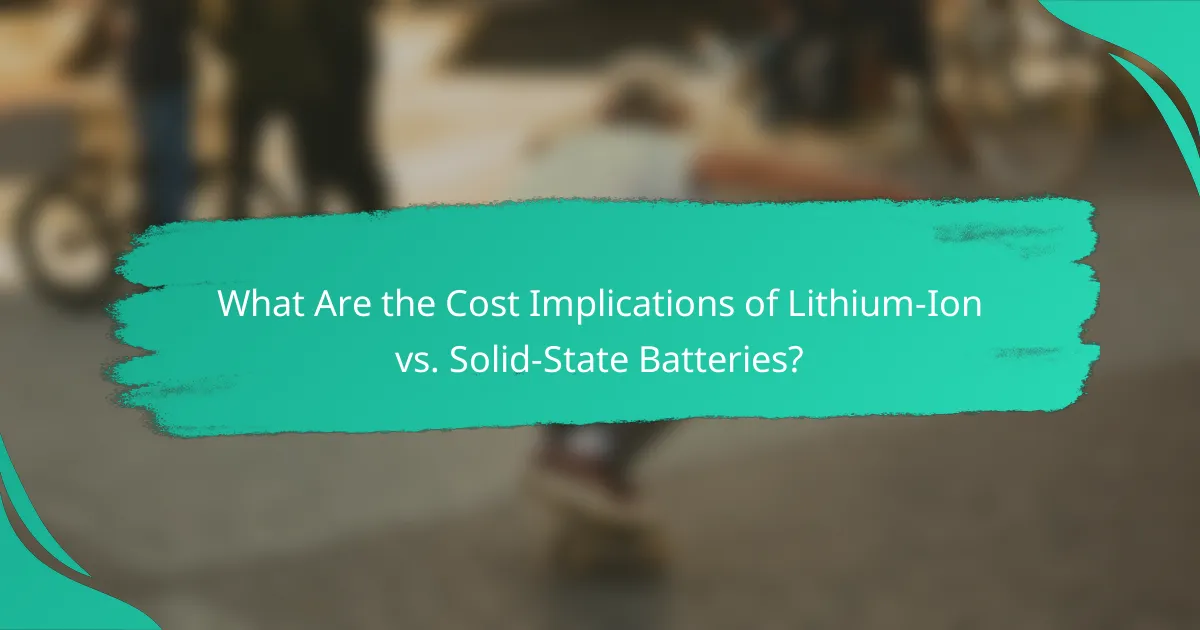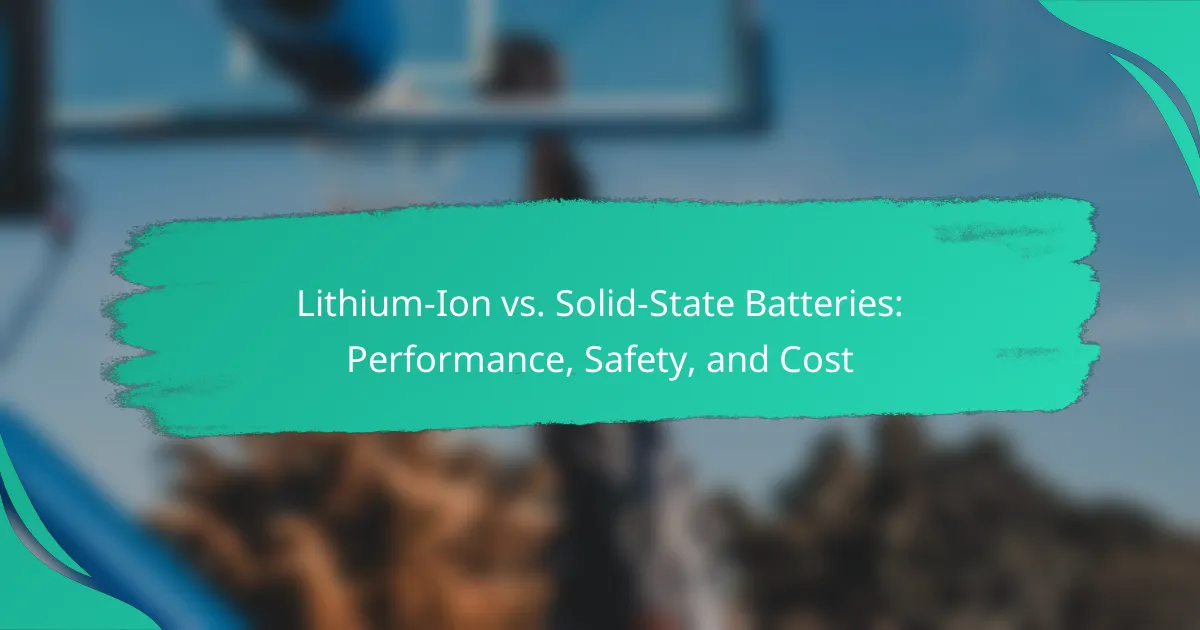Lithium-ion and solid-state batteries represent two distinct technologies in energy storage, each with unique advantages and challenges. While lithium-ion batteries are favored for their high energy density and efficiency, solid-state batteries promise improved safety and energy density through the use of solid electrolytes. However, the latter may face higher production costs and technical hurdles that impact their widespread adoption.

What Are the Key Differences Between Lithium-Ion and Solid-State Batteries?
Lithium-ion and solid-state batteries differ primarily in their construction, performance, and safety features. While lithium-ion batteries use liquid electrolytes, solid-state batteries utilize solid electrolytes, which can enhance energy density and safety but may come with higher costs and manufacturing challenges.
Energy density comparison
Energy density is a crucial factor when evaluating battery performance. Solid-state batteries generally offer higher energy density compared to lithium-ion batteries, allowing them to store more energy in a smaller volume. This can lead to longer-lasting power for electric vehicles and portable devices.
For instance, while lithium-ion batteries typically have energy densities around 150-250 Wh/kg, solid-state batteries can potentially reach 300 Wh/kg or more. This increase can significantly enhance the range of electric vehicles and the longevity of consumer electronics.
Charge cycles longevity
Charge cycle longevity refers to the number of times a battery can be charged and discharged before its capacity significantly diminishes. Solid-state batteries tend to have a longer lifespan than lithium-ion batteries, often exceeding 2,000 cycles compared to 500-1,500 cycles for lithium-ion options.
This longevity is particularly beneficial for applications where battery replacement is costly or inconvenient, such as in electric vehicles or renewable energy storage systems.
Temperature performance
Temperature performance is vital for battery safety and efficiency. Lithium-ion batteries can be sensitive to extreme temperatures, which may lead to reduced performance or safety hazards. Solid-state batteries, on the other hand, typically perform better in a wider temperature range, making them more suitable for various environments.
For example, solid-state batteries can operate effectively in temperatures from -20°C to 60°C, while lithium-ion batteries may struggle outside of 0°C to 40°C, impacting their usability in harsh conditions.
Weight and size variations
Weight and size are important considerations for portable applications. Solid-state batteries can be designed to be lighter and more compact due to their higher energy density. This can lead to more efficient designs in electric vehicles and consumer electronics.
For instance, a solid-state battery may allow for a smaller battery pack in an electric vehicle, contributing to overall weight reduction and improved efficiency.
Environmental impact
The environmental impact of battery production and disposal is increasingly important. Lithium-ion batteries often involve the extraction of metals like cobalt and lithium, which can have significant ecological consequences. Solid-state batteries, while still requiring raw materials, may reduce reliance on these metals and potentially offer safer disposal options.
As the industry moves towards more sustainable practices, solid-state batteries could play a key role in minimizing the environmental footprint of energy storage solutions.

How Do Lithium-Ion Batteries Perform in Real-World Applications?
Lithium-ion batteries are widely used in various applications due to their high energy density, efficiency, and relatively low self-discharge rates. Their performance can vary significantly based on the specific use case, including electric vehicles, consumer electronics, and energy storage systems.
Electric vehicles
In electric vehicles (EVs), lithium-ion batteries provide the necessary power and range, typically enabling distances of 200 to 400 kilometers on a single charge. Factors such as battery size, weight, and temperature can influence performance, with colder climates potentially reducing range by up to 20 percent.
Charging times for EVs using lithium-ion batteries can range from 30 minutes at fast-charging stations to several hours with standard home chargers. It’s essential for consumers to consider their driving habits and charging infrastructure when selecting an EV.
Consumer electronics
Lithium-ion batteries are the standard choice for consumer electronics, powering devices like smartphones and laptops. They offer quick charging capabilities, often reaching full charge in under two hours, and provide a lifespan of around 2 to 3 years with proper care.
Users should avoid letting their devices fully discharge frequently, as this can shorten battery life. Maintaining a charge level between 20 to 80 percent is generally recommended for optimal longevity.
Energy storage systems
In energy storage systems, lithium-ion batteries are favored for their ability to store and release energy efficiently, making them ideal for renewable energy applications. They can typically handle multiple charge and discharge cycles daily, with a lifespan of about 5 to 15 years depending on usage and maintenance.
When selecting a lithium-ion battery for energy storage, consider factors like capacity, discharge rates, and compatibility with existing systems. It’s also wise to evaluate local regulations and incentives for energy storage solutions, as these can impact overall costs and benefits.

What Are the Safety Considerations for Lithium-Ion Batteries?
Safety considerations for lithium-ion batteries include risks of thermal runaway, fire hazards, and adherence to regulatory standards. Understanding these factors is crucial for safe usage and handling of these batteries in various applications.
Thermal runaway risks
Thermal runaway occurs when a lithium-ion battery overheats, leading to a self-sustaining reaction that can cause fires or explosions. This can be triggered by factors such as manufacturing defects, physical damage, or excessive charging. Users should monitor battery temperatures and avoid exposing them to extreme conditions.
To mitigate thermal runaway risks, consider using batteries with built-in thermal management systems. Regularly inspect batteries for signs of swelling or damage, and replace any that show these symptoms to prevent potential hazards.
Fire hazards
Fire hazards associated with lithium-ion batteries stem from their flammable electrolyte and potential for short circuits. If a battery is punctured or improperly charged, it can ignite, posing risks to users and property. Proper storage and handling are essential to minimize these dangers.
Always store lithium-ion batteries in a cool, dry place away from flammable materials. Use chargers specifically designed for the battery type, and never leave charging batteries unattended for extended periods.
Regulatory standards
Regulatory standards for lithium-ion batteries vary by region but generally focus on safety, transport, and environmental impact. In the United States, the Department of Transportation (DOT) and Underwriters Laboratories (UL) provide guidelines to ensure safe manufacturing and usage. Compliance with these standards helps reduce risks associated with battery failures.
When purchasing lithium-ion batteries, look for certifications indicating compliance with relevant safety standards. Familiarize yourself with local regulations regarding battery disposal and recycling to ensure environmentally responsible practices.

What Are the Advantages of Solid-State Batteries?
Solid-state batteries offer several advantages over traditional lithium-ion batteries, including enhanced safety, improved energy efficiency, and a longer lifespan. These benefits stem from their unique construction, which replaces the liquid electrolyte with a solid electrolyte, reducing risks and improving performance.
Improved safety features
Solid-state batteries significantly enhance safety by eliminating the flammable liquid electrolyte found in lithium-ion batteries. This design reduces the risk of leaks, fires, and thermal runaway, making them a safer choice for applications in electric vehicles and consumer electronics.
Additionally, solid-state batteries can operate effectively in a wider range of temperatures, further minimizing safety concerns. Their robust structure also makes them less susceptible to physical damage, which is crucial for devices exposed to harsh conditions.
Higher energy efficiency
Energy efficiency is another key advantage of solid-state batteries. They typically have a higher energy density, meaning they can store more energy in a smaller volume compared to lithium-ion batteries. This characteristic allows for longer usage times between charges, which is particularly beneficial for electric vehicles and portable electronics.
Moreover, solid-state batteries can maintain their efficiency over a broader temperature range, ensuring consistent performance. This efficiency translates into less energy wasted during charging and discharging cycles, making them a more sustainable option in the long run.
Longer lifespan
Solid-state batteries generally have a longer lifespan than their lithium-ion counterparts, often lasting several thousand charge cycles before significant degradation occurs. This longevity is attributed to the stable solid electrolyte, which reduces wear and tear during charging and discharging processes.
For consumers, this means fewer replacements and lower overall costs over time. In applications like electric vehicles, a longer battery life can enhance resale value and reduce the environmental impact associated with battery disposal and production.

What Are the Cost Implications of Lithium-Ion vs. Solid-State Batteries?
The cost implications of lithium-ion and solid-state batteries vary significantly, impacting their adoption in various applications. While lithium-ion batteries are currently more affordable, solid-state batteries promise enhanced performance and safety, which may justify their higher initial costs in the long run.
Manufacturing costs
Manufacturing costs for lithium-ion batteries are generally lower due to established production processes and economies of scale. In contrast, solid-state batteries require advanced materials and techniques, leading to higher production expenses. As technology advances and production scales up, these costs may decrease, making solid-state batteries more competitive.
Market pricing trends
Market pricing trends indicate that lithium-ion batteries dominate the current market due to their lower prices, typically ranging from $100 to $200 per kilowatt-hour. Solid-state batteries, however, are priced significantly higher, often exceeding $300 per kilowatt-hour. As research progresses and production methods improve, the price gap may narrow, potentially increasing the market share of solid-state technology.
Cost per cycle analysis
Cost per cycle analysis reveals that lithium-ion batteries generally offer a lower cost per cycle, often around $0.10 to $0.20, depending on usage and lifespan. Solid-state batteries, while initially more expensive, could provide longer lifespans and higher cycle counts, potentially reducing their effective cost per cycle over time. Evaluating the total cost of ownership, including lifespan and performance, is crucial when comparing these technologies.
